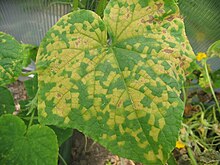| Pseudoperonospora cubensis | |
|---|---|

| |
| P. cubensis on cucumber leaf | |
| Scientific classification | |
| Domain: | Eukaryota |
| Clade: | Diaphoretickes |
| Clade: | SAR |
| Clade: | Stramenopiles |
| Phylum: | Oomycota |
| Order: | Peronosporales |
| Family: | Peronosporaceae |
| Genus: | Pseudoperonospora |
| Species: | P. cubensis
|
| Binomial name | |
| Pseudoperonospora cubensis (Berk. & M.A. Curtis) Rostovzev
| |
Pseudoperonospora cubensis is a species of water mould known for causing downy mildew on cucurbits such as cantaloupe, cucumber, pumpkin, squash and watermelon. This water mould is an important pathogen of all these crops, especially in areas with high humidity and rainfall, such as the eastern United States. In most years the disease is an annual, late-season problem on squash and pumpkin in the eastern and central United States, however, since 2004 it has become one of the most important diseases in cucumber production.[1] Considered a highly destructive foliar disease of cucurbits, successful breeding in the mid-twentieth century provided adequate control of downy mildew in cucumber without the use of fungicides. The resurgence in virulence has caused growers great concern and substantial economic losses, while downy mildew in other cucurbit crops continues to be a yearly hindrance.
- ^ Holmes, G., Wehner, T. and Thornton, A. 2006. An old enemy re-emerges: downy mildew rears its ugly head on cucumber, impacting growers up and down the Eastern U.S. American Vegetable Grower, Feb. pp. 14-15.